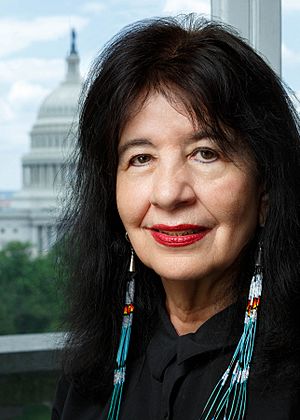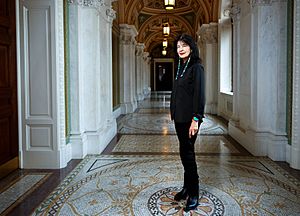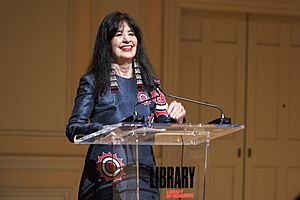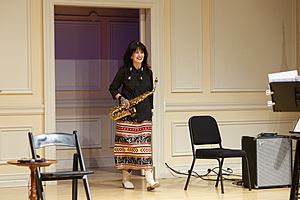Joy Harjo facts for kids
Quick facts for kids
Joy Harjo
|
|
|---|---|
 |
|
| Born | May 9, 1951 Tulsa, Oklahoma, U.S. |
| Pen name | Joy Harjo-Sapulpa |
| Occupation | Author, poet, performer, educator, United States Poet Laureate |
| Nationality | Muscogee Nation, American |
| Education | University of New Mexico (BA) University of Iowa (MFA) |
| Genre | Poetry, non-fiction, fiction |
| Literary movement | Native American Renaissance |
| United States Poet Laureate | |
| In office 2019–2022 |
|
| Preceded by | Tracy K. Smith |
| Succeeded by | Ada Limón |
Joy Harjo (born May 9, 1951) is an amazing American poet, musician, and author. She made history as the first Native American to be named the United States Poet Laureate. This special role means she was the nation's official poet from 2019 to 2022.
Joy Harjo is a proud citizen of the Muscogee Nation. She is a very important writer in what's called the Native American Renaissance. This was a time when many Native American artists shared their stories and culture. She studied at the Institute of American Indian Arts and later earned degrees from the University of New Mexico and the University of Iowa.
Besides writing, Harjo has taught at many universities. She performs her poetry and music all over the world. She has released seven music albums and written ten books of poetry. She also wrote three children's books: The Good Luck Cat, For a Girl Becoming, and Remember.
Harjo has won many awards for her work. These include the 2024 Frost Medal and the 2023 Bollingen Prize for American Poetry. She has also been inducted into the Oklahoma Hall of Fame and the National Women's Hall of Fame. As Poet Laureate, she created a project called Living Nations, Living Words. It was a map of the U.S. that featured poems by Native Nations poets.
Contents
Early Life and Education
Joy Harjo was born in Tulsa, Oklahoma, on May 9, 1951. Her father was a citizen of the Muscogee Nation. Her mother had Irish, French, and Cherokee roots. Joy Harjo is an enrolled citizen of the Muscogee Nation.
Her family, especially her mother, aunts, and grandmother, inspired her creativity. She wrote her first poem when she was in eighth grade.
When she was 16, Harjo went to the Institute of American Indian Arts in Santa Fe, New Mexico. She loved painting and found it a great way to express herself. Her great-aunt, Lois Harjo Ball, was also a painter and inspired her.
Harjo first planned to study medicine at the University of New Mexico. But she soon changed her major to art. In her last year, she switched to creative writing. She was inspired by Native American writers like Simon J. Ortiz and Leslie Marmon Silko. Her first book of poems, The Last Song, was published in 1975. She earned her Master of Fine Arts degree in creative writing from the University of Iowa in 1978.
Career Highlights
Harjo has taught at many universities across the United States. These include the Institute of American Indian Arts and the University of New Mexico. One of her students at the University of New Mexico was Deb Haaland, who later became a Congresswoman.
Harjo plays the alto saxophone and flutes. She performs her music and poetry solo and with her band, the Arrow Dynamics Band. She has performed in many countries and at big events like the 1996 Summer Olympics.
In 1995, she received a Lifetime Achievement Award from the Native Writers' Circle of the Americas. In 2008, she helped start the Native Arts and Cultures Foundation. She also served as its Board Chair in 2019.
In 2019, Joy Harjo was named the United States Poet Laureate. She was the first Native American to hold this important position. She was also the second Poet Laureate to serve three terms. In 2022, she became the first artist-in-residence for the Bob Dylan Center in Tulsa, Oklahoma.
Harjo has been inducted into several important halls of fame. These include the National Women's Hall of Fame and the National Native American Hall of Fame.
Literature and Performance
Joy Harjo has written many poems, books, and plays. Her works often explore themes like finding your identity, the power of art, and social justice.
She uses oral history, which is how stories are passed down by speaking, in her work. She believes that written words are like "fixed orality" for her. This means her writing captures the feeling of spoken stories. When she performs, she tells stories, sings, and changes her voice to keep her audience interested. She says she starts with a sound, not just an image, when she writes poetry.
Her first book of poems, The Last Song, came out in 1975. Since then, she has written ten poetry books. Her recent book, Weaving Sundown in a Scarlet Light: 50 Poems for 50 Years (2022), celebrates her 50 years of writing. Her book An American Sunrise (2019) won an Oklahoma Book Award. Her memoir, Crazy Brave, won the PEN USA Literary Award.
Harjo has also written three children's books. She has edited several collections of writing by Native Nations writers. One important collection is When the Light of the World was Subdued, Our Songs Came Through. She also edited Living Nations, Living Words, which goes with her Poet Laureate project.
Her poetry is even in space! It's included on a plaque on LUCY, a NASA spacecraft. LUCY launched in 2021 to explore asteroids near Jupiter.
Poetry Themes

Joy Harjo's interest in art started early. As a teenager, she used painting to express herself. She attended the Institute of Native American Arts. There, she worked to change how Native American art was seen. She later became a creative writing major, focusing on poetry after hearing other Native American poets.
She began writing poetry at age 22. Her first book, The Last Song, launched her writing career. In her book She Had Some Horses, Harjo gives deep meanings to animals, especially horses. For her, horses are not just animals. They are connected to ancestors, nature, and even spirits.
Harjo explains that horses can transform. They can be "a streak of sunrise, a body of sand, a moment of ecstasy." She also shares how her father had a special connection with horses. He could "speak with them" and even "bend time" when riding. This shows a link between her father, horses, and ancestor spirits. Her latest collection, Weaving Sundown in a Scarlet Light (2022), celebrates her 50 years of writing poetry.
Music
As a musician, Joy Harjo has released seven CDs. These albums feature her own music and music by other Native American artists.
Her first album was Letter From the End of the Twentieth Century (2003). Her solo album Native Joy for Real came out in 1998. She has won many awards for her music. This includes a Native American Music Award (NAMMY) for Best Female Artist of the year in 2008. Her newest album, I Pray for My Enemies, was released in 2021.
Harjo performs with her saxophone and flutes. She plays alone or with her band, the Arrow Dynamics Band. She has performed in many countries, including Europe, South America, India, and Africa. She has also played at big events in North America.
She started playing the saxophone when she was 40 years old. Harjo believes that music helps her poems reach people's hearts in a different way. When she reads her poems, her voice has a musical tone, making each poem feel like a song.
Activism
Joy Harjo is not just a writer; she also speaks out about important issues. She writes and talks about U.S. politics and Native American affairs. As a member of the Muscogee Nation, she uses her poetry to be "a voice of the Indigenous people."
Her poetry often explores how colonization has affected Native Americans. She writes about its impact, including violence against women. Harjo's work shows how Native American issues like sovereignty (self-governance) and social conditions are connected to larger global issues.
Harjo's work often reflects her Muscogee/Creek background and spiritual beliefs. She uses her art to help people understand past wrongs. This includes issues faced by Native American communities and other oppressed groups. She believes in unity and that humans, animals, plants, sky, and earth are all connected. Harjo thinks we become truly human when we understand these connections. She also believes that colonization led to Native American women being treated unfairly within their own communities. She works to encourage more equality between genders.
Awards and Recognition
Joy Harjo has received many honors for her contributions to literature and culture.
- In 1995, she received a Lifetime Achievement Award from the Native Writers Circle of The Americas.
- She was inducted into the Mvskoke Creek Nation Hall of Fame in 2012.
- In 2013, her memoir Crazy Brave won the American Book Award and the PEN USA Literary Award.
- She received a Guggenheim Fellowship in 2014.
- In 2015, she won the Wallace Stevens Award in Poetry.
- She received the Ruth Lilly Poetry Prize in 2017 and the Jackson Prize in 2019.
- In 2019, she was named the United States Poet Laureate.
- Her book An American Sunrise won the Oklahoma Book Award in 2020.
- In 2021, she was inducted into the National Women's Hall of Fame and the Native American Hall of Fame.
- She received the Ivan Sandrof Lifetime Achievement Award in 2023.
- In 2024, she received an honorary Doctor of Letters from the University of St Andrews.
- Harjo is an elected member of several prestigious groups, including the American Academy of Arts and Letters.
Personal Life
Joy Harjo has two children. She raised them as a single mother. She is married to Owen Chopoksa Sapulpa. She is also a stepmother to his children.
Works
Bibliography
Poetic Works
- The Last Song (1975)
- What Moon Drove Me to This? (1979)
- She Had Some Horses (1983)
- In Mad Love and War (1990)
- The Woman Who Fell From the Sky (1994)
- A Map to the Next World: Poetry and Tales (2000)
- How We Became Human: New and Selected Poems 1975–2001 (2002)
- Conflict Resolution for Holy Beings (2015)
- An American Sunrise (2019)
- Weaving Sundown in a Scarlet Light: 50 Poems for 50 Years (2022)
As Editor
- Reinventing the Enemy's Language: Contemporary Native Women's Writings of North America (1997)
- When the Light of the World Was Subdued, Our Songs Came Through: A Norton Anthology of Native Nations Poetry (2020)
- Living Nations, Living Words: An Anthology of First Peoples Poetry (2021)
Plays
- Wings of Night Sky, Wings of Morning Light, A Play (2019)
Non-fiction
- Crazy Brave: A Memoir (2012)
- Poet Warrior: A Memoir (2021)
Children's Literature
- The Good Luck Cat (2000)
- For a Girl Becoming (2009)
- Remember (2023)
Discography
Solo Albums
- Letter from the End of the Twentieth Century (2003)
- Native Joy for Real (2004)
- She Had Some Horses (2006)
- Winding Through the Milky Way (2008)
- Red Dreams, A Trail Beyond Tears (2010)
- I Pray For My Enemies (2021)
Singles
- This America (2011)
Joy Harjo and Poetic Justice
- Letter from the End of the Twentieth Century (1997)
See also
 In Spanish: Joy Harjo para niños
In Spanish: Joy Harjo para niños
- List of writers from peoples indigenous to the Americas
- Native American Studies



